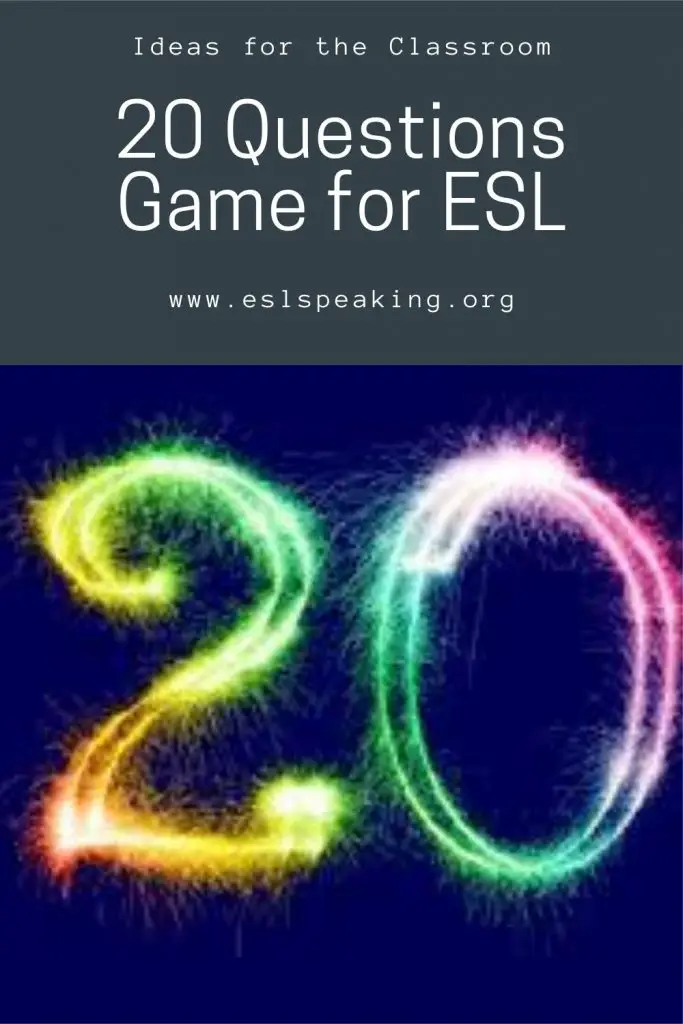If you’re looking for a fun, simple ESL game that focuses on yes/no questions and answers, try out the 20 questions game. You can play the regular version, or adapt the game 20 questions to suit the age and level of students.

20 questions ESL speaking game
I’m sure you’ve played the game “20 questions” before. Someone thinks of a secret noun (person, place or thing) and the other team or person gets to ask up to 20 questions to figure out what it is. It’s a fun way to get ESL/EFL students practicing questions and working on some basic vocabulary.
For kids, I often narrow down the choices for them and sometimes will allow fewer questions. Perhaps 10 questions instead of 20. This is because it can get kind of boring with so many questions because each round takes so long. Also, for simple topics like animals, 10 questions is a nice challenge but 20 is far too easy.
Some topic examples that work well for 20 questions include animals, jobs or sports. It just depends on whatever you’re teaching in class that day.
20 Questions for ESL Students
Skills: Speaking/Listening
Time: 20 minutes
Level: Beginner-advanced
Materials Required: Nothing
This is a “20 questions” style game, based on whatever you’re studying (Animals/Jobs, etc). For advanced students, you could just leave it open and use this as a bit of warm-up at the beginning of class instead of as a review activity.
In groups, the students ask the teacher a yes/no question. After the teacher gives the answer, the students can have one chance to guess the secret thing. Play a few rounds and the team with the most points is the winner.
The traditional way is that a guess counts as an answer in this question game. So you can either ask a question or guess what it is. The way you play is up to you and depends on the age and level of the students.
You can also have students take turns being the one with the “secret.” This is actually a bit better because it’s more student-centred. Students have to listen well, instead of just focusing on asking the questions. I usually make the student quickly tell me their secret thing so that I can assist if necessary and keep the game on track.
Overall, it’s an excellent way for students to practice asking questions in English. Just be sure that students are actually making sentences!
3 Rules for ESL 20 Questions Game
I put in a few rules that make things go more smoothly:
- A guess counts as a “question” if you choose to play it this way. This prevents random guesses which don’t make the game very fun. Or, you can also play it where the team gets one question, and then one guess.
- The team or person must use a full sentence to ask a question.
- The questions have to be Yes/No ones.
- For children, emphasize that they must tell the truth at all times! And, also they should choose something that everyone knows, instead of some obscure, random thing.

20 questions game for adults ESL
ESL Questions Game: Good for a Big Class?
This activity is ideal for small classes of up to 8 students. This way, everyone can play together.
However, if you have a very large class, divide the students up into smaller groups and have them play with each other. I find that groups of 4-6 work best for this.
Make sure you let your students know that you can help them if necessary. For example, if a student gets a question but they’re not sure about whether they should answer yes or no.
As a further requirement, you can have students take turns asking questions so that everyone gets a chance to work on their English speaking. If the students asking questions use up their 20 questions (or 10), then the person with the secret thing gets a point.
How to Adapt the Twenty Questions Game for ESL/EFL
Adapting the 20 Questions game for English as a Second Language (ESL) learners can be a fun and effective way to practice language skills. Here are some tips on how to do it:
Simplify Language
Use simpler language in your questions and answers. Avoid complex sentence structures and vocabulary that might be challenging for ESL learners.
Provide Examples
Before starting the game, give examples of questions they could ask. For instance, “Is it a person?”, “Can you find it in a house?”, etc.
Encourage Vocabulary Building
Choose categories that align with the ESL learners’ vocabulary level or the current lesson’s theme. This will help them practice words and phrases related to that topic.
Use Visual Aids
Consider using pictures or flashcards to accompany the object being guessed. Visual aids can help reinforce the understanding of the word.
Allow Extra Questions
If necessary, you could give learners a few more than 20 questions to work with, especially if they’re just getting used to the game.
Promote Group Discussions
Encourage learners to discuss possible questions in small groups before asking the official question. This can help them brainstorm and gain confidence.
Provide Feedback
After each round, discuss the questions and answers. Explain any mistakes or offer alternative phrasing to help them improve.
Practice Different Grammatical Structures
Incorporate different grammar structures into the questions. For example, “Does it have…?”, “Is it…ing?”, “Can it…?” This way, learners can practice various sentence forms.
Start with Familiar Topics
Begin with topics that are familiar to the learners, such as animals, colors, food, etc. This can make the game less intimidating.
Model Correct Pronunciation
While playing, pay attention to the learners’ pronunciation and provide correct models if needed.
Incorporate Review
If you’re teaching specific vocabulary or grammar concepts, choose objects related to those concepts to provide additional practice.
Rotate Roles
Have different learners take turns being the guesser and the one providing answers. This gives everyone a chance to practice both asking questions and responding.
Vary Difficulty Levels
Depending on the learners’ proficiency, you can adjust the difficulty of the objects being guessed. Start with easier objects and gradually introduce more challenging ones.
More ESL Activities
- Amazon Kindle Edition
- Smith, Jennifer Booker (Author)
- English (Publication Language)
- 144 Pages - 03/31/2016 (Publication Date)
If you like this ESL question game, here’s something you need to check out.
You’re going to love this book over on Amazon: 101 ESL Activities: For Kids (6-13). It’ll be easier than ever to plan fun, engaging and interesting English lessons for your elementary or middle school kids.
The key to happy students is varied, challenging and interesting games and activities. This book will help you do that while making your lesson planning easier at the same time.
The good news is that the book is available on Amazon in both print and digital formats. The (cheaper!) digital copy can be read on any device by downloading the free Kindle reading app.
Keep a copy on your office bookshelf. Have a copy on your phone for lesson planning on the go.
You can check out the book for yourself over on Amazon, but only if you want to make your life easier:
Game 20 Questions FAQs
There are a number of common questions that people have about the game twenty questions. Here are the answers to some of the most popular ones.
What is the 20 Questions game?
It’s a guessing game where one person thinks of an object, and the other players have 20 yes-or-no questions to figure out what it is.
How many questions do players get?
Players get 20 questions to guess the object.
Can the questions be more complex than yes or no?
No, only yes/no questions are allowed in the twenty-question game.
What happens if the guess is correct?
If the guess is correct, the game ends, and the guesser wins.
What if the guess is incorrect after 20 questions?
If the guess isn’t correct after 20 questions, the guesser loses, and the object holder wins.
Can players repeat questions?
Players can’t repeat the exact same question, but they can ask similar ones.
Is there a time limit for each question?
There’s usually no strict time limit, but the game should progress at a reasonable pace.
Can the object be anything in the world?
Yes, the object can be anything that the players can ask yes-or-no questions about.
Is it better to ask broad or specific questions?
It’s often better to start with broader questions and narrow down as more information is gathered.
Can the object holder give hints?
No, the object holder can only answer “yes” or “no.”
Is this game suitable for any age group?
Yes, it can be adapted for various age groups and levels of difficulty.
Is the game limited to physical objects?
No, the game can also involve concepts, places, animals, and more.
What’s the strategy for being a good guesser?
Start with broad categories and then ask questions that help eliminate possibilities.
Can the object be fictional, like from a book or movie?
Yes, the object can be fictional or real.
Is the game competitive or cooperative?
It can be played both competitively and cooperatively, depending on the group’s preference.
Are gestures or charades allowed?
Typically, gestures and charades aren’t allowed; the game relies on verbal questions.
Is the game more about deduction or luck?
The game heavily involves deduction and logical thinking rather than luck.
Have your Say about 20 Questions
What do you think about this ESL speaking and listening activity? Leave a comment below and let us know.
Oh, and don’t forget to share this on Facebook, Twitter, or Pinterest.
Last update on 2025-06-12 / Affiliate links / Images from Amazon Product Advertising API






Love the idea of using this game for ESL students too with a few adaptations for lower-level students!
Love the idea of turning this game into an ESL version. Or, just playing the regular way with more advanced level students.
I do twenty questions with a few objects in a bag. One student selects an object and the others ask questions.
As a warm-up I might put an example out and ask them to write all the words they can think of to describe the object (ball of string, toy car, comb, earring etc). Useful for eliciting adjectives and correcting spelling.